Solving University Course Timetabling Problems Using Constriction Particle Swarm Optimization with Local Search
Abstract
:1. Introduction
2. Course Timetabling Problem
- (1)
- Each teacher can only teach one class in the same timeslot (teaching two courses at the same time is prohibited).
- (2)
- Each classroom can only be used for one course in the same timeslot (having two courses taught in the same classroom at the same time is not permitted).
- (3)
- Each class can only attend one course in any given timeslot.
- (4)
- A three-credit course must be arranged in consecutive hours, not on two separate days or with an interrupting lunch break.
- (5)
- No courses are to be conducted in the third and fourth hours each Thursday as that is the time for the weekly school (class) assembly and for the class tutor.
- (6)
- According to regulations, teachers holding first-level supervisory positions are to teach two classes each week.
- (7)
- Teachers concurrently holding first-level and second-level administrative positions or supervisory positions of academic units are not to teach any classes on Thursday afternoon.
- (1)
- Class time conflicts between the required courses of each year should be avoided to facilitate students’ course retake and credit makeup.
- (2)
- Course timetabling should be conducted according to the timeslot preferences of teachers and students as well as the levels of preference.
- (3)
- Each teacher may not teach more hours than the limit stipulated by the undergraduate department or graduate institute.
- (4)
- Each full-time teacher must teach classes for at least three days a week.
3. Particle Swarm Optimization Algorithm
- (1)
- The initial position and velocity of each particle in the Nth dimension are determined randomly.
- (2)
- The fitness value of each particle is assessed according to the defined objective function.
- (3)
- If the fitness value of each particle’s current location is better than its Pbest, the Pbest is set to the current position.
- (4)
- The fitness value of the particle is compared with that of the Gbest. If it is better, the Gbest is updated.
- (5)
- Equation (1) as shown below is applied to update the velocity and position of each particle.
- (6)
- The process is repeated from Step 2 until the termination criterion is met or the optimal solution in the universe is obtained.
- Vid is the velocity component of the ith particle in the dth dimension.
- Xid is the position component of the ith particle in the dth dimension.
- c1 is the cognitive learning factor.
- c2 is the social learning factor.
- Pid is the position component of the Pbest of the ith particle in the dth dimension.
- Pgd is the position component of the Gbest in the dth dimension.
- Rand() is a random number between [0, 1].
3.1. The Inertia Weights
3.2. Constriction Factors
3.3. Particle Encoding
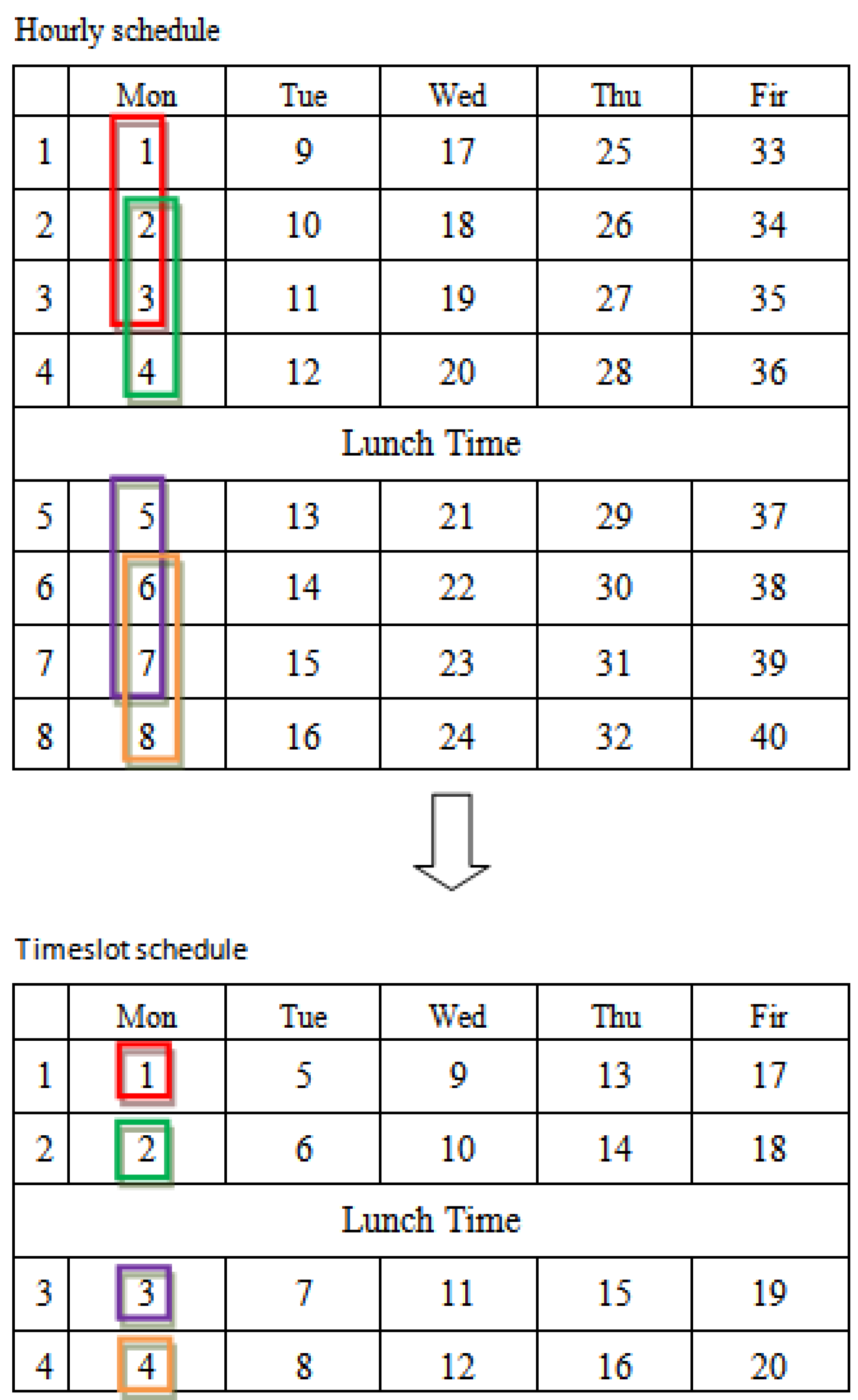


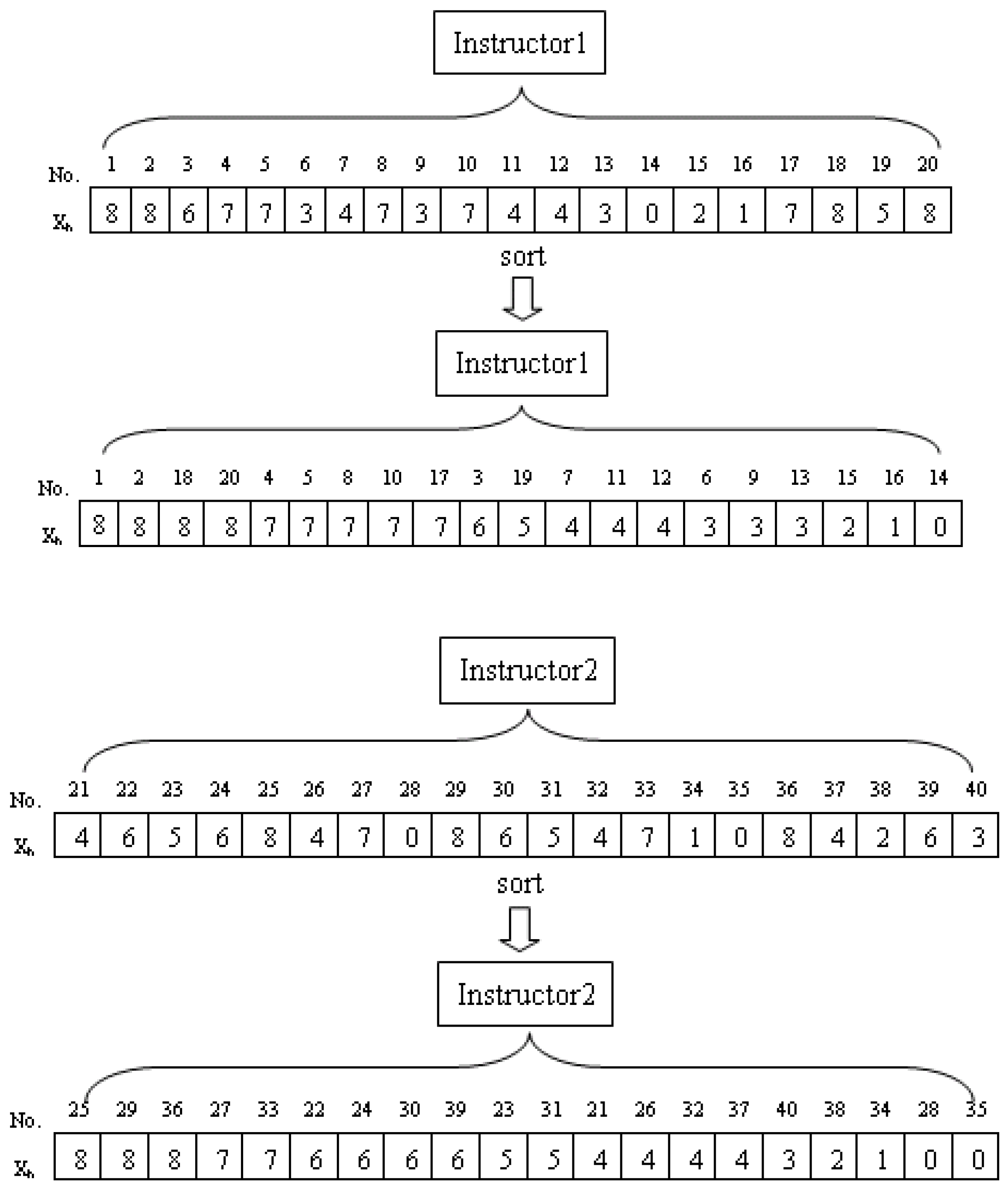
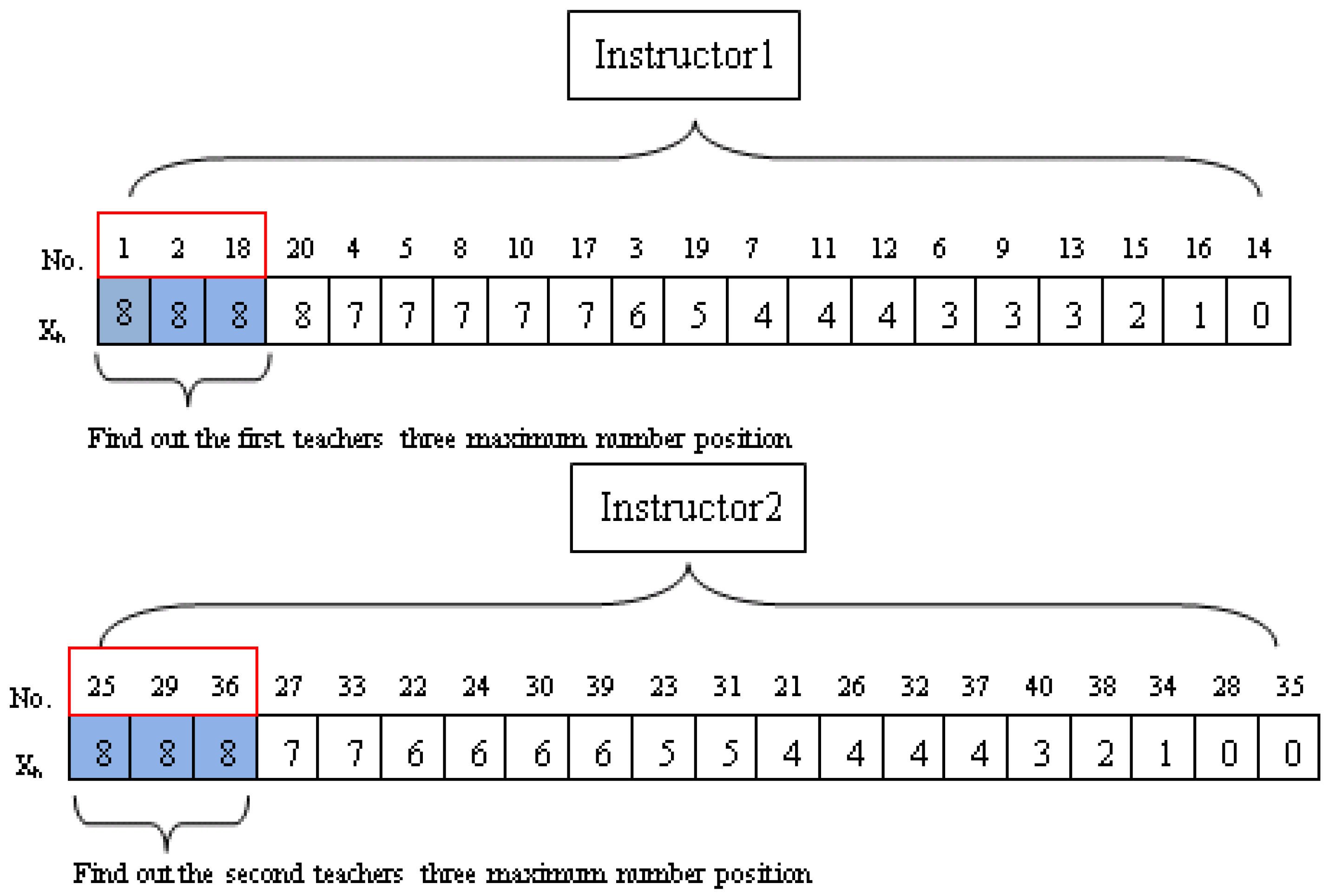

3.4. Fitness Function
| Timeslot | Mon | Tue | Wed | Thu | Fir |
|---|---|---|---|---|---|
| 1 | 1 | 5 | 3 | 5 | 4 |
| 2 | 1 | 4 | 2 | 5 | 3 |
| Lunch Break | |||||
| 3 | 2 | 4 | 2 | −10 | 2 |
| 4 | 2 | 4 | −10 | −10 | 2 |
3.5. PSO with Local Search
4. Experimental Results and Discussion
- (1)
- Prioritization of teachersThe prioritization of teachers in course timetabling will have a significant effect on the results of course timetabling, therefore, no specific teacher’s timetable should be assigned first and they are thus assigned randomly.
- (2)
- Course dataThe data regarding the courses a teacher will teach needs to be established before the semester begins. Such data includes the teacher code, course code, class code of the class to take the course in question, teacher’s status, number of class hours, classroom, etc.
- (3)
- Classroom dataClassrooms involve certain particular factors. A teacher is assigned to maintain and manage each one of the classrooms of the Computer Science and Information Engineering Department where this study was performed and all the classes to be taught by a teacher are normally arranged to be conducted in the classroom that the teacher is assigned to maintain and manage. Restated, if classroom A is placed under the management of teacher A, the courses that teacher A teaches will be preferably conducted in classroom A. Since the number of teachers in the department is larger than the number of classrooms, some classrooms are placed under the management of two or more teachers.
- (4)
- Handling of teacher, class and classroom schedules conflictsA class time conflict may happen when two teacher timeslots, classroom timeslots and course timeslots overlap and it becomes an infeasible solution. To avoid an endless search for solutions to class time conflicts in all timeslots, such conflicts are singled out from timeslots as being infeasible solutions and assessed whether they should be discarded according to the satisfaction level.
4.1. Particle Quantity Analysis
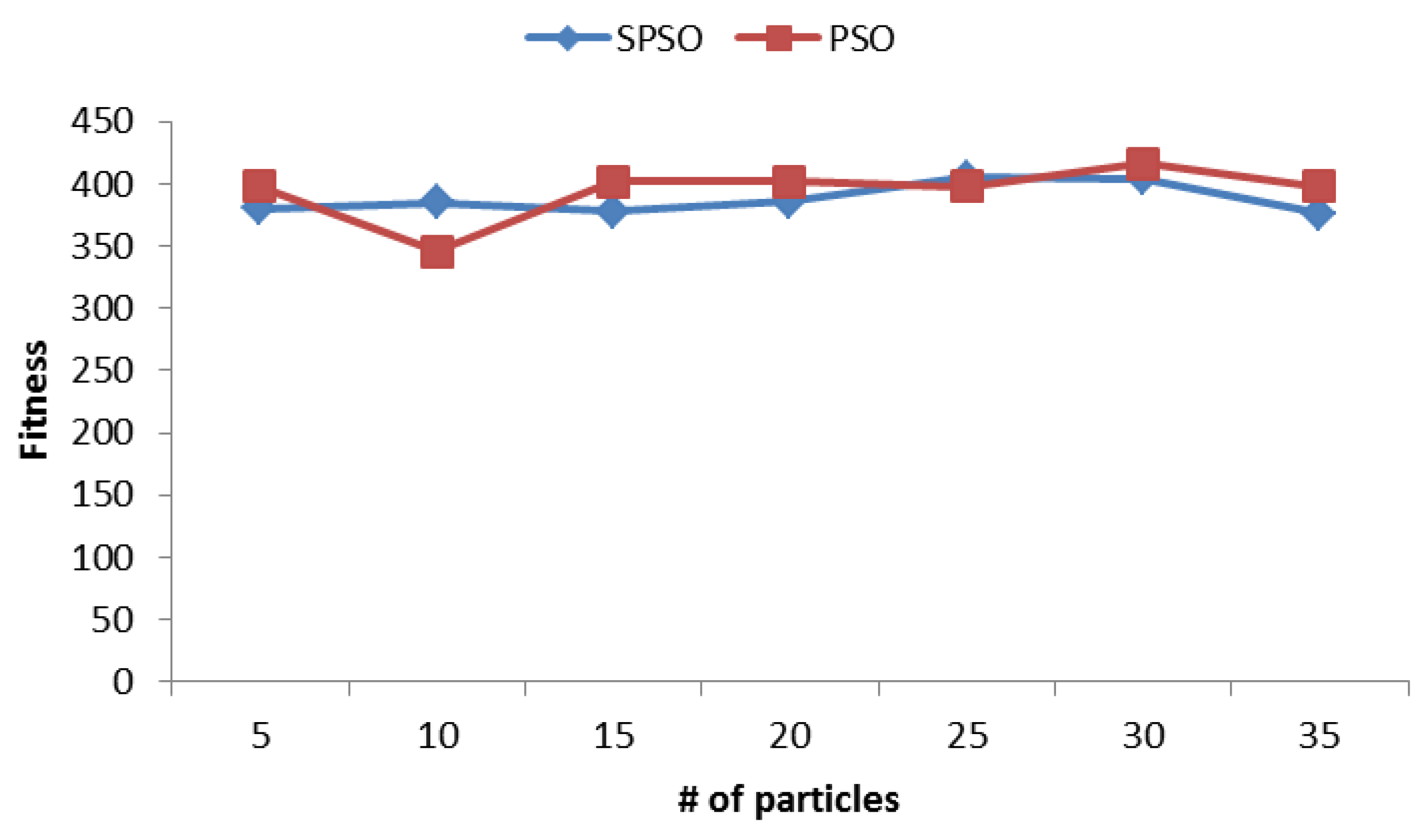
4.2. Inertia Weight Analysis

4.3. Learning Factor Analysis
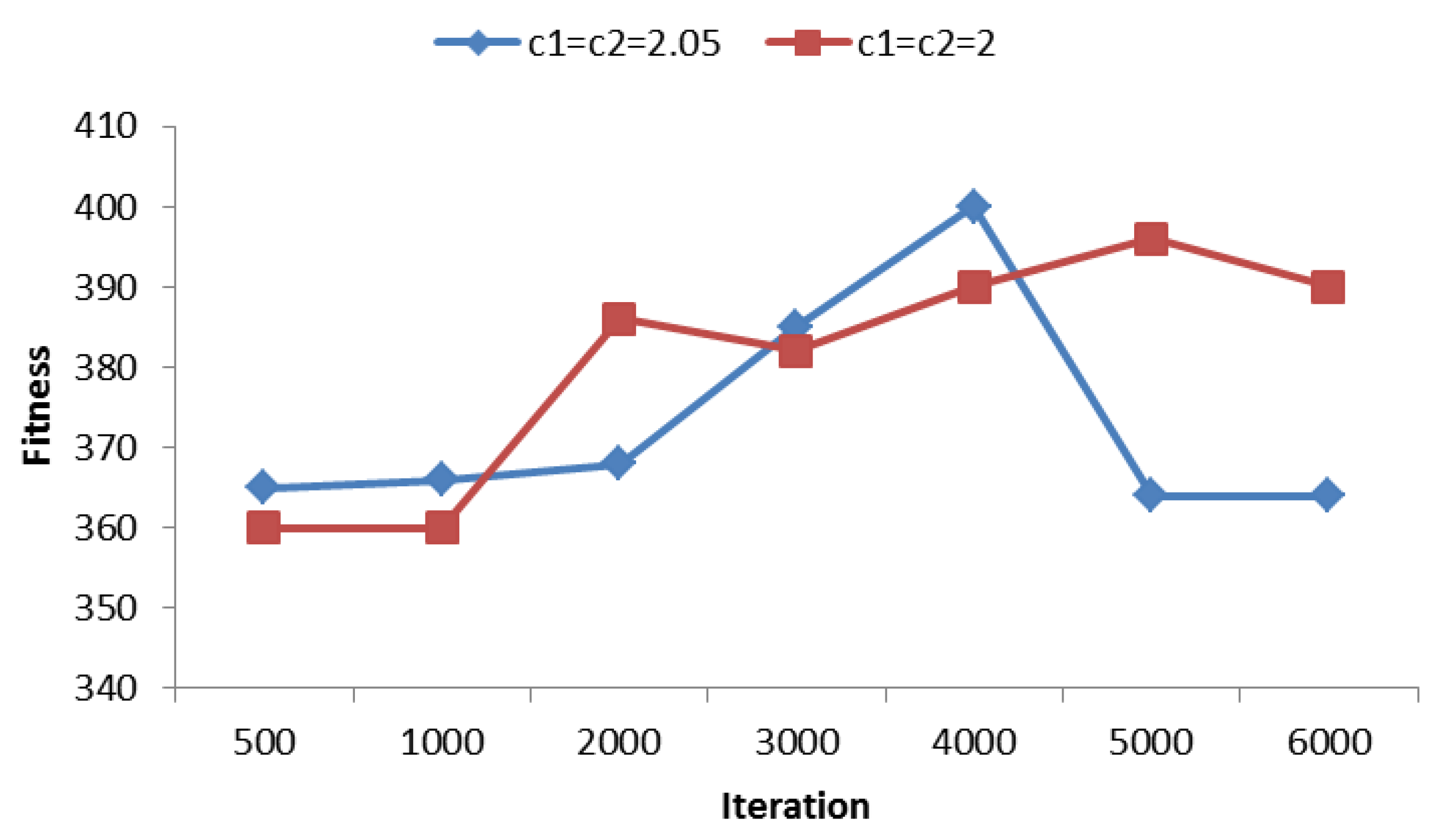
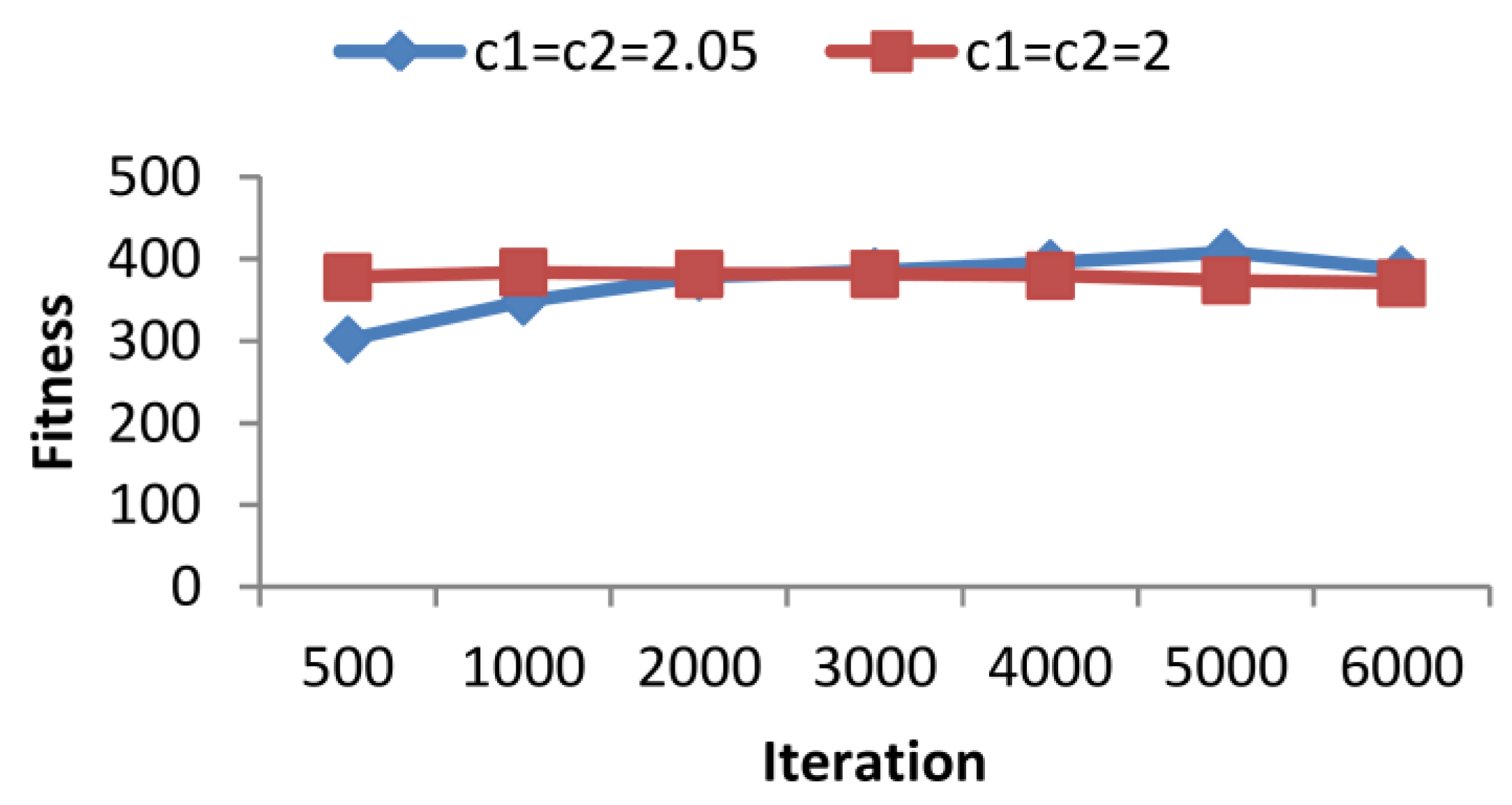
4.4. Performance Comparison between PSO and SPSO with/without Local Search
| Iteration | PSO V = −3~3 | PSOLS V = −3~3 | PSO V = −4~4 | PSOLS V = −4~4 |
|---|---|---|---|---|
| 2000 | 384 | 398 | 368 | 402 |
| 3000 | 370 | 402 | 385 | 414 |
| 4000 | 380 | 402 | 400 | 396 |
| 5000 | 396 | 416 | 396 | 410 |
| 6000 | 375 | 404 | 380 | 402 |
| Average | 381 | 404.4 | 385.8 | 404.8 |
| Iteration | PSO V = −3~3 | PSOLS V = −3~3 | PSO V = −4~4 | PSOLS V = −4~4 |
|---|---|---|---|---|
| 2000 | 362 | 386 | 386 | 400 |
| 3000 | 370 | 403 | 382 | 412 |
| 4000 | 396 | 404 | 390 | 412 |
| 5000 | 390 | 404 | 374 | 390 |
| 6000 | 368 | 402 | 361 | 420 |
| Average | 377.2 | 399.8 | 378.6 | 406.8 |
| Iteration | SPSO V = −3~3 | SPSOLS V = −3~3 | SPSO V = −4~4 | SPSOLS V = −4~4 |
|---|---|---|---|---|
| 2000 | 381 | 398 | 376 | 378 |
| 3000 | 371 | 384 | 392 | 410 |
| 4000 | 396 | 418 | 394 | 410 |
| 5000 | 380 | 384 | 374 | 419 |
| 6000 | 392 | 415 | 392 | 418 |
| Average | 384 | 399.8 | 385.6 | 407 |
| Iteration | SPSO V = −3~3 | SPSOLS V = −3~3 | SPSO V = −4~4 | SPSOLS V = −4~4 |
|---|---|---|---|---|
| 2000 | 400 | 412 | 375 | 401 |
| 3000 | 408 | 416 | 394 | 412 |
| 4000 | 402 | 416 | 410 | 424 |
| 5000 | 398 | 390 | 380 | 412 |
| 6000 | 406 | 424 | 398 | 408 |
| Average | 402.8 | 411.6 | 391.4 | 411.4 |
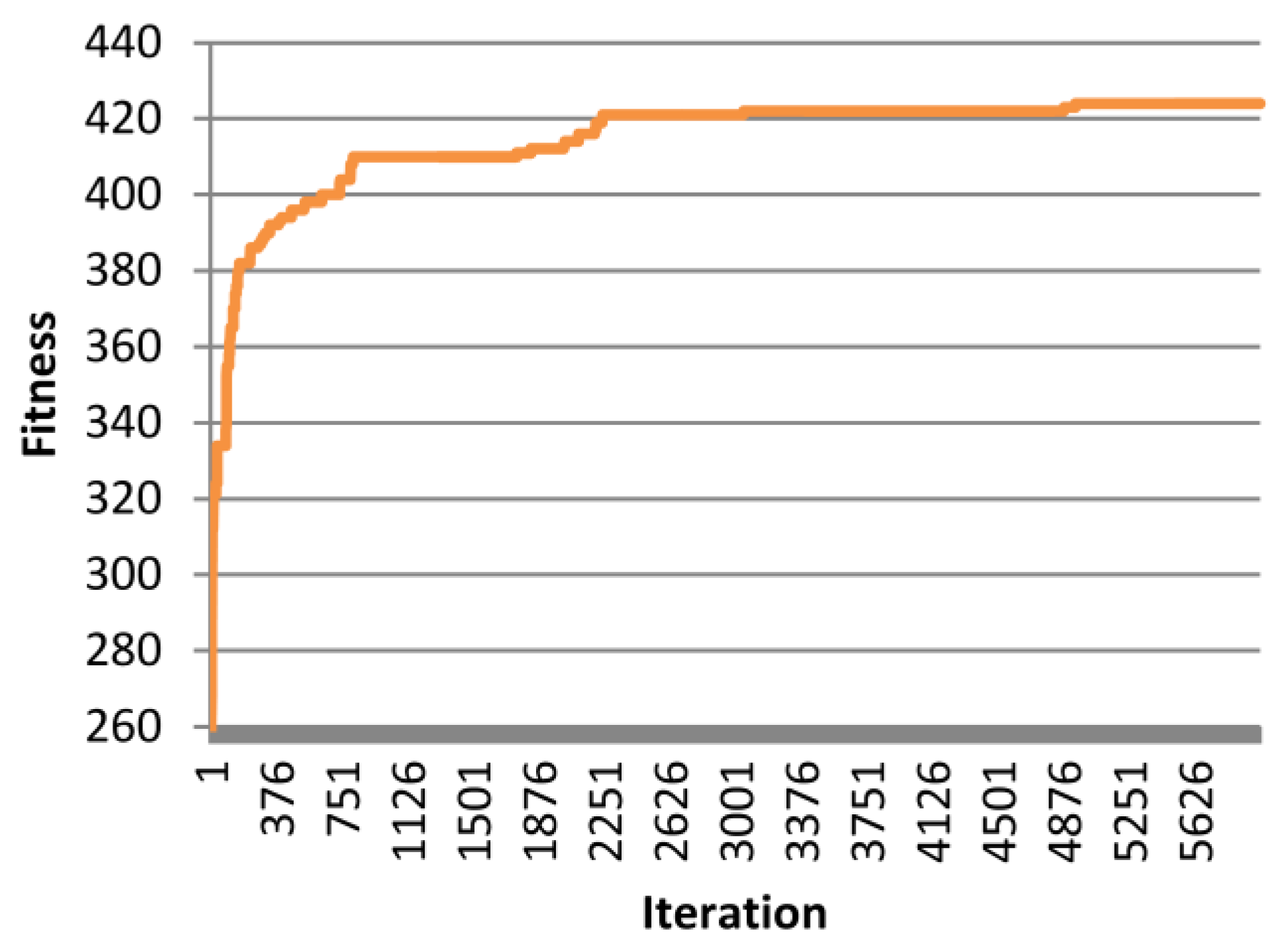

5. Conclusions
- (1)
- With local search added in PSO and SPSO, the satisfaction (fitness value) of the teachers and classes is better than the fitness value obtained without adding local search. This confirms that the quality of solutions can be improved by applying the proposed scheme in this paper.
- (2)
- The results from application of different parameters show that use of SPSOLS obtains the best solution (the best fitness of 424 and maximum average fitness of 411.6). Restated, SPSOLS outperforms PSOLS.
Acknowledgments
Conflict of Interest
References
- Mooney, E.L.; Rardin, R.L.; Parmenter, W.J. Large scale classroom scheduling. IIE Trans. 1995, 28, 369–378. [Google Scholar] [CrossRef]
- Even, S.; Itai, A.; Shamir, A. On the Complexity of Timetable and Multi-Commodity Flow Problems. In Proceedings of the 16th IEEE Annual Symposium on Foundations of Computer Science, California, CA, USA, 13–15 October 1975; pp. 184–193. [Google Scholar]
- Herz, A. Tabu search for large scale timetabling problems. Eur. J. Oper. Res. 1991, 54, 39–47. [Google Scholar] [CrossRef]
- Masood, A.B. A two-stage multiobjective scheduling model for faculty-course-time assignment. Eur. J. Oper. Res. 1996, 94, 16–28. [Google Scholar]
- Werra, D. Restricted coloring models for timetabling. Discret. Math. 1997, 165–166, 161–170. [Google Scholar] [CrossRef]
- Abdullah, S.; Turabieh, H. Generating university course timetable using genetic algorithm and local search. In Proceedings of the 3rd International Conference on Convergence and Hybrid Information Technology, Busan, Korea, 11–13 November 2008; pp. 254–260. [Google Scholar]
- Cambazard, H.; Hebrard, E.; O’Sullivan, B.; Papadopoulos, A. Local search and constraint programming for the post enrolment-based course timetabling problem. Ann. Oper. Res. 2012, 194, 111–135. [Google Scholar] [CrossRef]
- Gunawan, A.; Ng, K.M.; Poh, K.L. A hybridized Lagrangian relaxation and simulated annealing method for the course timetabling problem. Comput. Oper. Res. 2012, 39, 3074–3088. [Google Scholar] [CrossRef]
- Burke, E.K.; Elliman, D.G.; Weare, R.F. Application of genetic algorithm for solving university timetabling problems: A case study of Thai universities. In Proceedings of the 7th WSEAS International Conference on Simulation, Modelling and Optimization, Beijing, China, 15–17 September, 2007; pp. 128–133. [Google Scholar]
- Nothegger, C.; Mayer, A.; Chwatal, A.; Raidl, G. Solving the post enrolment course timetabling problem by ant colony optimisation. Ann. Oper. Res. 2012, 194, 325–339. [Google Scholar] [CrossRef]
- Shiau, D.F. A hybrid particle swarm optimization for a university course scheduling problem with flexible preferences. Expert Syst. Appl. 2011, 38, 235–248. [Google Scholar] [CrossRef]
- Tassopoulos, I.X.; Beligiannis, G.N. A hybrid particle swarm optimization based algorithm for high school timetabling problems. Appl. Soft Comput. 2012, 12, 3472–3489. [Google Scholar] [CrossRef]
- Al-Betar, M.A.; Khader, A.T.; Zaman, M. University course timetabling using a hybrid harmony search metaheuristic algorithm. IEEE Trans. Syst. Man Cybern. Rev. 2012, 42, 664–681. [Google Scholar] [CrossRef]
- Jat, S.; Yang, S. A hybrid genetic algorithm and tabu search approach for post enrolment course timetabling. J. Sched. 2010, 14, 617–637. [Google Scholar] [CrossRef]
- Kennedy, J.; Eberhart, R. Particle Swarm Optimization. In Proceedings of the Fourth IEEE International Conference on Neural Networks, Perth, WA, USA, 27 November–1 December 1995; pp. 1942–1948. [Google Scholar]
- Marinakis, Y.; Marinaki, M. A hybrid multi-swarm particle swarm optimization algorithm for the probabilistic traveling salesman problem. Comput. Oper. Res. 2010, 37, 432–442. [Google Scholar] [CrossRef]
- Liu, B.; Wang, L.; Jin, Y.H. An Effective PSO-Based Memetic Algorithm for Flow Shop Scheduling. IEEE Trans. Syst. Man Cybern. Rev. 2007, 37, 18–27. [Google Scholar] [CrossRef]
- Shen, H.; Zhu, Y.; Liu, T.; Jin, L. Particle Swarm Optimization in Solving Vehicle Routing Problem. ICICTA 09’ Second International Conference on Intelligent Computation Technology and Automation, Hunan, China, 10–11 October 2009; pp. 287–291. [Google Scholar]
- Chen, R.M.; Wang, C.M. Project scheduling heuristics based standard PSO for task-resource assignment in heterogeneous grid. Abstr. Appl. Anal. 2011, 2011. [Google Scholar] [CrossRef]
- Chen, R.M.; Wu, C.L.; Wang, C.M.; Lo, S.T. Using a novel particle swarm optimization scheme to solve resource-constrained scheduling problem in PSPLIB. Expert Syst. Appl. 2010, 37, 1899–1910. [Google Scholar] [CrossRef]
- Chen, R.M. Particle swarm optimization with justification and designed mechanisms for resource-constrained project scheduling problem. Expert Syst. Appl. 2011, 38, 7102–7111. [Google Scholar] [CrossRef]
- Shi, Y.; Eberhart, R. A Modified Particle Swarm Optimizer. In Proceedings of the IEEE International Conference on Evolutionary Computation, Anchorage, Piscataway, NJ, USA, 4–9 May 1998; pp. 69–73. [Google Scholar]
- Clerc, M. The Swarm and the Queen: Towards a Deterministic and Adaptive Particle Swarm Optimization. In Proceedings of the Congress on Evolutionary Computation, Washington, DC, USA, 6–9 July 1999; pp. 1951–1957. [Google Scholar]
- Eberhart, R.; Shi, Y. Comparing Inertia Weights and Constriction Factors in Particle Swarm Optimization. In Proceedings of the 2000 IEEE Congress on Evolutionary Computation, La Jolla, CA, USA, 16–19 July 2000; pp. 84–88. [Google Scholar]
- Bratton, D.; Kennedy, J. Defining a Standard for Particle Swarm Optimization. In Proceedings of the 2007 IEEE Swarm Intelligence Symposium, Honolulu, HI, USA, 1–5 April 2007; pp. 120–127. [Google Scholar]
- Clerc, M.; Kennedy, J. The particle swarm—Explosion, stability, and convergence in a multidimensional complex space. IEEE Trans. Evol. Comput. 2002, 6, 58–73. [Google Scholar] [CrossRef]
- Tsai, S.J.; Sun, T.Y.; Liu, C.C.; Hsieh, S.T.; Wu, W.C.; Chiu, S.Y. An improved multi-objective particle swarm optimizer for multi-objective problems. Expert Syst. Appl. 2010, 37, 5872–5886. [Google Scholar] [CrossRef]
© 2013 by the authors. licensee MDPI, Basel, Switzerland. This article is an open access article distributed under the terms and conditions of the Creative Commons Attribution license (http://creativecommons.org/licenses/by/3.0/).
Share and Cite
Chen, R.-M.; Shih, H.-F. Solving University Course Timetabling Problems Using Constriction Particle Swarm Optimization with Local Search. Algorithms 2013, 6, 227-244. https://doi.org/10.3390/a6020227
Chen R-M, Shih H-F. Solving University Course Timetabling Problems Using Constriction Particle Swarm Optimization with Local Search. Algorithms. 2013; 6(2):227-244. https://doi.org/10.3390/a6020227
Chicago/Turabian StyleChen, Ruey-Maw, and Hsiao-Fang Shih. 2013. "Solving University Course Timetabling Problems Using Constriction Particle Swarm Optimization with Local Search" Algorithms 6, no. 2: 227-244. https://doi.org/10.3390/a6020227




